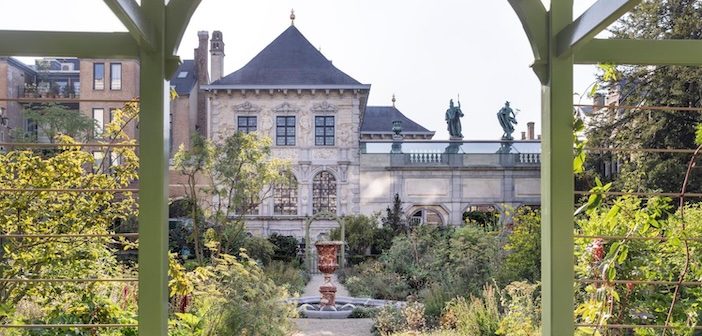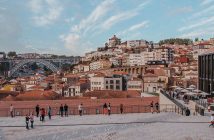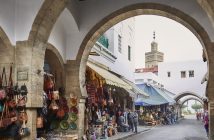In 1608, after eight years living in Rome, the Flemish painter and diplomat Peter Paul Rubens returned to Flanders and the family home in Antwerp, due to his mother’s ill-health. Much has been made of his life as an artist, but Rubens always preferred to be considered a nobleman more than a painter. Coming from an upper middle-class family, he was to become a successful, wealthy man – ultimately knighted by Philip IV of Spain in 1624 and then by Charles I in 1630 – and a glimpse into his lifestyle, and that of the great and the good of 17th century Flanders, can be seen in the re-opening of one of the city’s star attractions.
Once in Antwerp, he purchased an impressive mansion along the Wapper (a rectangular stretch of land in the centre of the city) and within its grounds built a studio for his work and a stunningly beautiful garden. Today, while the Rubenshuis is currently closed for restoration, this ‘enclosed’ garden, a hortus conclusus, has been restored and is now one of the must-sees on a visit to the city.
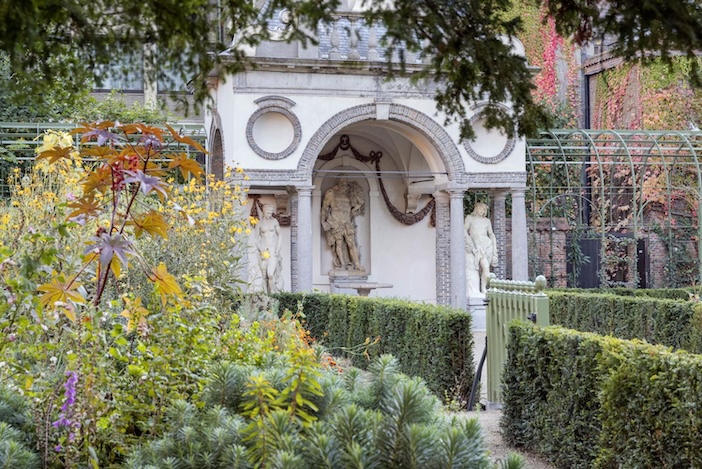
Rubens House garden, view of the pavilion (photo by Ans Brys, courtesy of Rubenshuis)
Rubens loved his gardens, both at the Rubenshuis and at his country retreat, a small castle, Het Steen, at Elewijt in Flemish Brabant. In the Rubenshuis, he considered the garden an extension of the house, to entertain friends and clients, and a space for his children to play and his family to be at leisure.
A devoted family man, Rubens had three children with Isabella Brant, whom he married in1609 soon after his return from Rome. They are depicted in an informal marriage portrait Rubens and Isabella Brant in the Honeysuckle Bower, in which, notably, garden plants were significantly included. Isabella died of the plague in 1626, aged thirty-five, and Rubens later married his second wife Helena Fourment in 1630 – she was sixteen and Rubens fifty-three – the same year that he retired from political life as a diplomat, wanting to commit more time at home.
The garden’s surrounding buildings show the influence of ancient Rome in their design, suggesting Rubens’ affection for Roman antiquity from his time there. He designed his garden to include a Roman portico and pavilion, a colonnade and classical sculptures. The house’s main entrance from the street was accessed through vast wooden doors leading directly into a courtyard with a Roman-style portico that included monumental statues looking down on visitors.
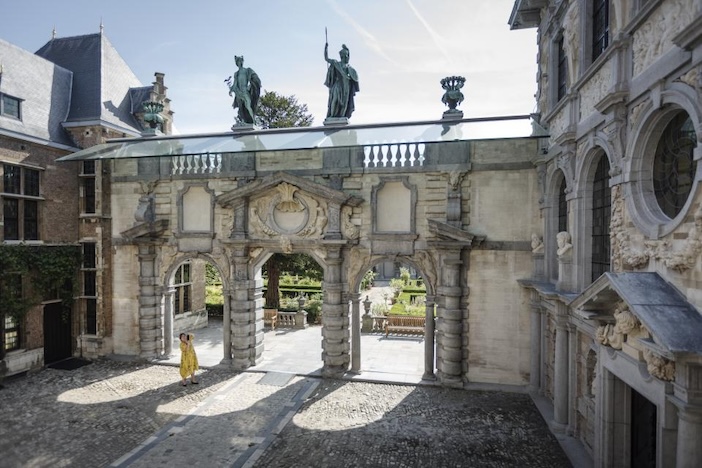
The Portico of the Rubenshuis (photo by Ans Brys, courtesy of Rubenshuis)
This portico leads to the enclosed garden, square in shape with a surrounding walkway and pathways through it. To enter from the busy, noisy street is to walk into an oasis where city sounds evaporate as the visual effect of the most beautiful, enchanting garden appears. As beautiful, in fact, as one of Rubens’ own paintings.
Rubens frequently featured landscapes and gardens in his work. Rubens, Helena Fourment and their son Frans, from 1635, is a self-portrait of the artist with his second wife Helena and features one of their five children, in a version of his Antwerp garden as backdrop. Another, Rubens and his second wife in the garden (The Walk in the Garden), has the Roman pavilion from his garden prominently depicted.
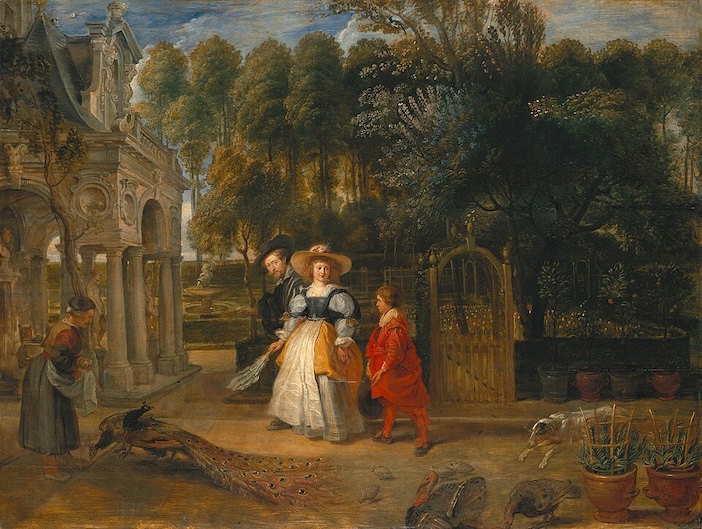
Peter Paul Rubens and Studio, The Walk in the Garden, c. 1630-1631, Bayerische Staatsgemäldesammlunge (Munich)
Painted in 1640 with his workshop, Rubens, Helena, and their son Nicolaas, are taking a ‘promenade’, a popular pastime. Rubens’ prized orange and lemon trees – a visual symbol of wealth – are featured, in tubs, and at their feet are a pair of peacocks, turkeys and small birds, their a pet dog running through the garden. It is an intimate family scene.
Another point of interest, behind them is a colourful tulip garden in full flower. Today, the space is divided into two large parterres, each with a fountain at centre, and here Rubens grew the highly fashionable flower. First recorded in China in 750AD, tulips were introduced to European countries from Persia in the 1550s. Initially, in the Netherlands only professional growers could sell the bulbs, but when this was relaxed in 1633, the trade ballooned as demand outstripped supply and prices exploded until, in 1637, the tulip ‘bubble’ inevitably collapsed.
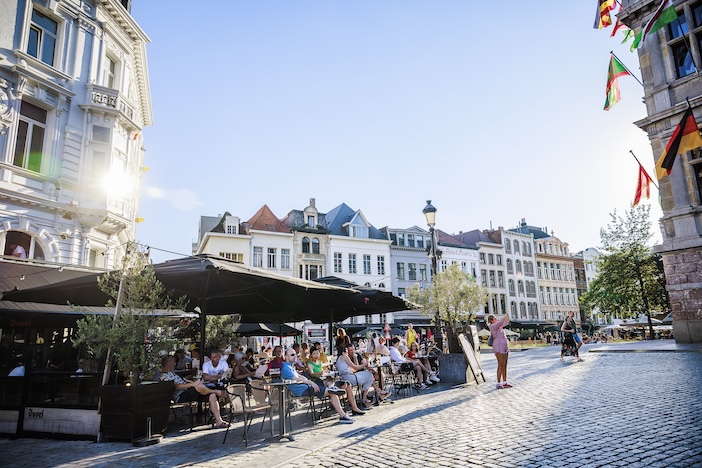
Grotemarkt, Antwerp (photo by Victoriano Moreno, courtesy of Visit Antwerp)
At its peak, in Antwerp, a rare tulip bulb could cost 1,800 guilders. By comparison Rubens’ highest paid servant received a salary of 72 guilders per year. New research by the Rubenshuis garden curator Klara Alen, has revealed that Antwerp was just as much a centre for the tulip trade as Amsterdam, Leiden and Haarlem.
A tulip collectors’ club met at De Zwaan Inn – in the present day Graanmarkt – and the city’s tulip market was held only 200 metres from Rubenshuis. A painting by the Antwerp-born artist Jan Breughel the Younger, Allegory on Tulip Mania, depicting monkeys as tulip traders and buyers, is a mocking jest of the fickle Antwerp bulb trade.
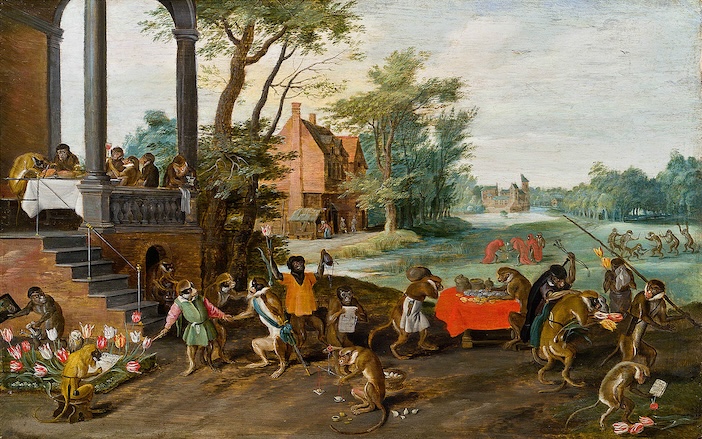
A Satire of Tulip Mania by Jan Brueghel the Younger (c. 1640)
A second ‘must-see’ in Antwerp is the Museum Plantin-Moretus, the original home and publishing workshop owned by the Plantin-Moretus family. On this site since the sixteenth-century, it too has an enclosed garden with sculpted wall busts of family members. It features the oldest printing presses in the world and centuries-old collections of rare books.
The Plantin-Moretus publishing house was patronised by Rubens, and it is recorded that on 2nd February 1615 he purchased a limited edition copy of Hortus Eystettens from the shop of Balthasar I and Jan II Moretus for 98 guilders, possibly the most expensive book in Rubens’ collection. He would consult it to learn about the plants for his Renaissance-style garden, including varieties of tulips.
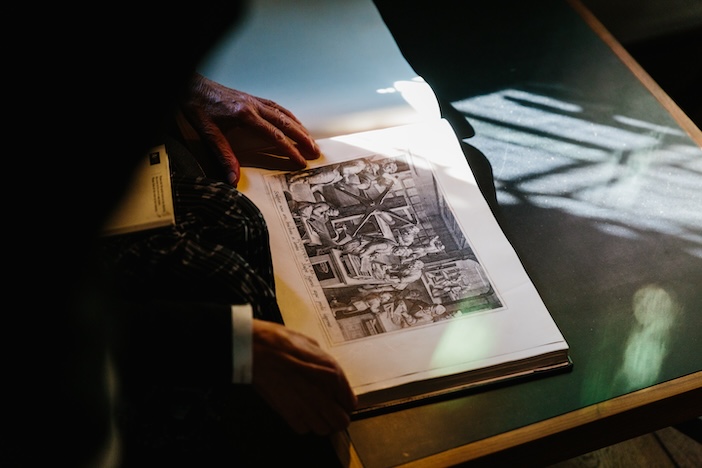
The history of the enclosed garden goes back to the first gardens laid out in Persia, enclosing water sources, created on the principles of the hortus conclusus and the paradise garden, or Garden of Eden, which has a symbolic meaning in different religions; the source of life and plants and a precious space for contemplation and protection against evil.
In the historic centre of Antwerp, in the walled garden of St George’s church, Ronald van der Hilst, world-famous for design and landscape architecture, has created an enclosed garden complete that is something of a ‘plant laboratory’, testing unknown species to see how they develop in the changing climate.
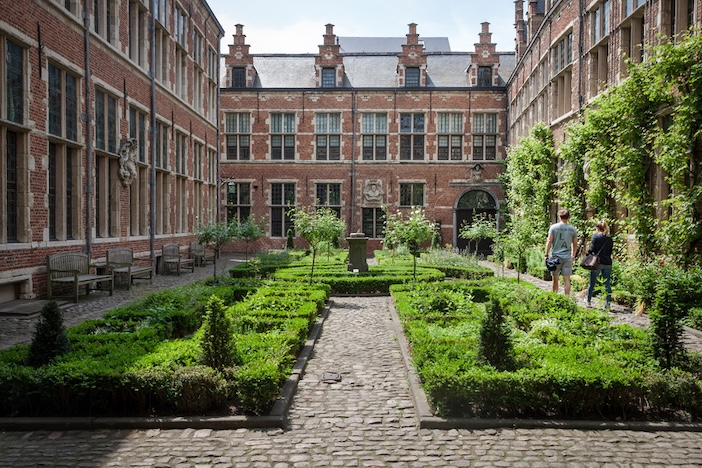
The south-facing garden next to the church, soaks up the sun and heat and the micro-climate allows van der Hilst to create a sublime garden of robust plants, including some rare tulip bulbs. His house and shop is across the road, selling handmade tulip vases, and tulip plants, and an exquisite eau de parfum Hortus Conclusus tulipa based on the scent of the wild tulip Tulipa sylvestris, the first time it has been introduced into a perfume.
Peter Paul Rubens was buried in the chancel of St James’s Church in 1640, a few hundred metres from his house and garden in Antwerp. In his lifetime, Rubens’ success afforded him the trappings of a lavish lifestyle, one epitomised in the Rubenshuis and garden, now beautifully restored, and offering a window into his world. It is a taste of things to come ahead of the completion of restoration on the house, and to visit it is to step not just into one of his paintings, but into the lifestyle of one of the 17th century’s great figures.
For more information about Rubenshuis and garden, including details of tours, and to start planning your trip, please visit www.rubenshuis.be. For more information about Antwerp and Flanders, please visit the official tourism websites at www.visitantwerpen.be and www.visitflanders.com. To read more about Rubens’ garden, curator Klara Alen’s knowledgeable book The Rubens Garden: A Masterpiece in Bloom, Hannibal Books, 2024, is well worth a read.
Header photo by Ans Brys (courtesy of Rubenshuis)

